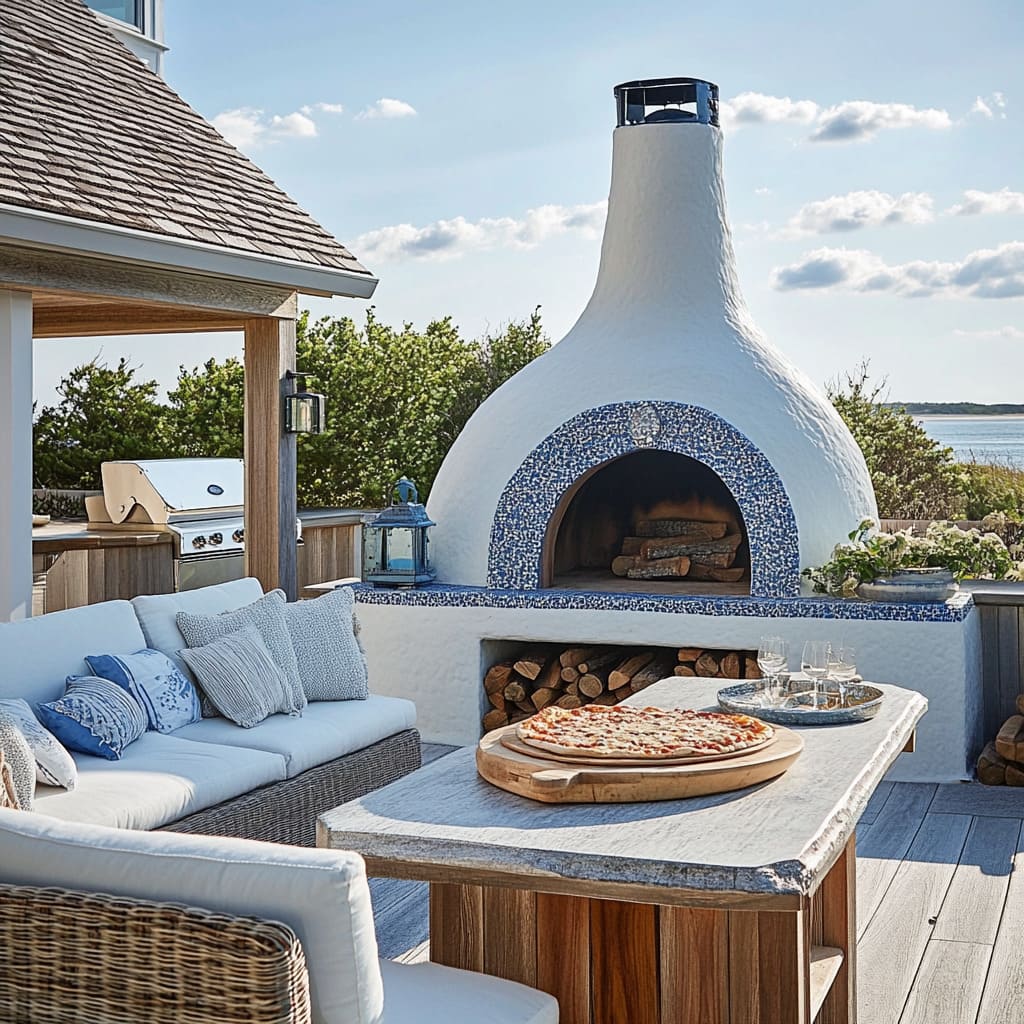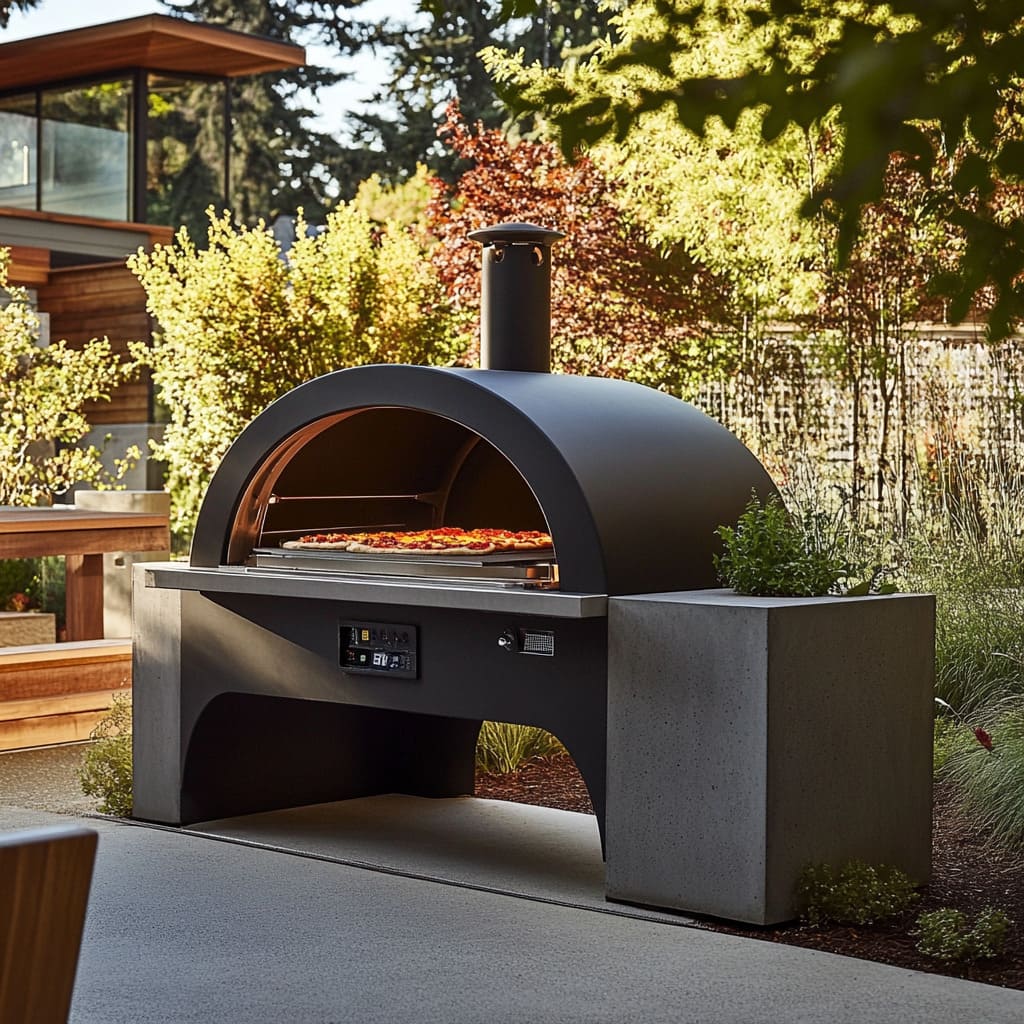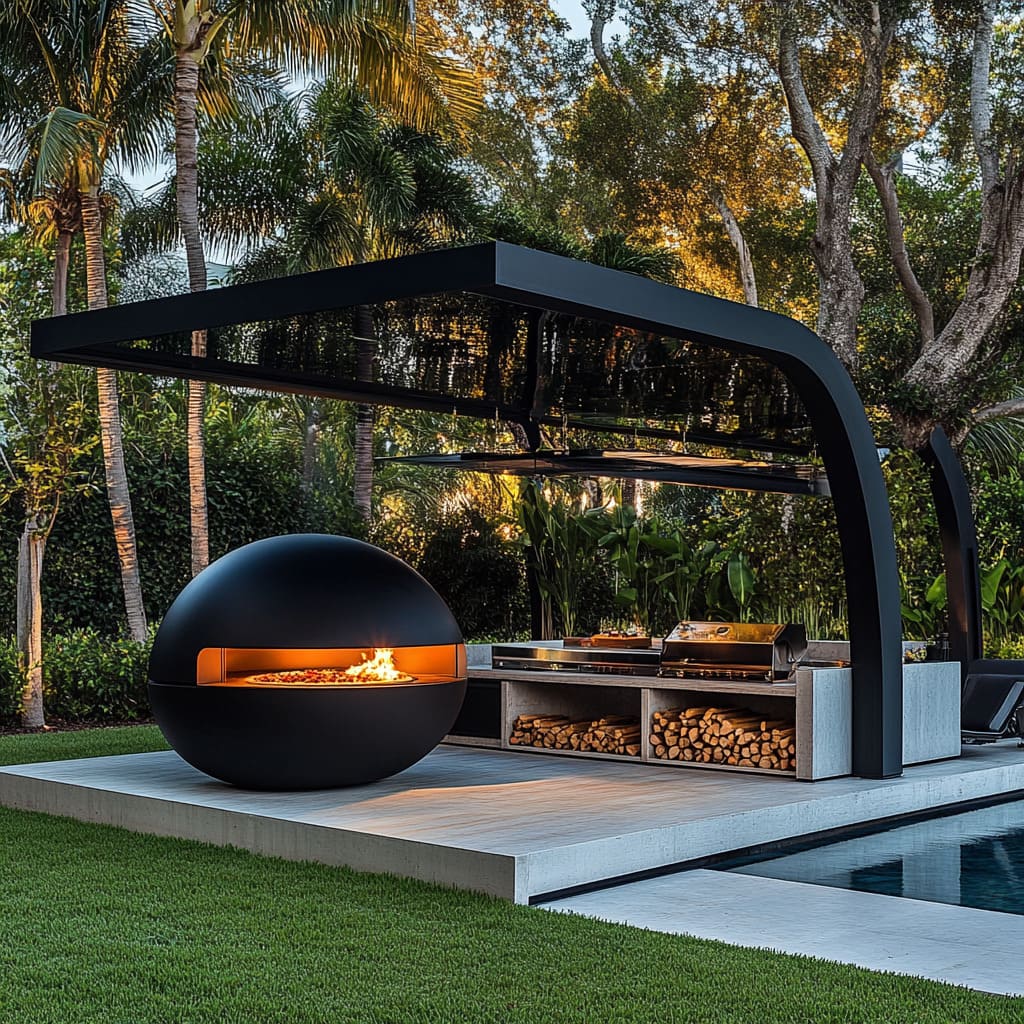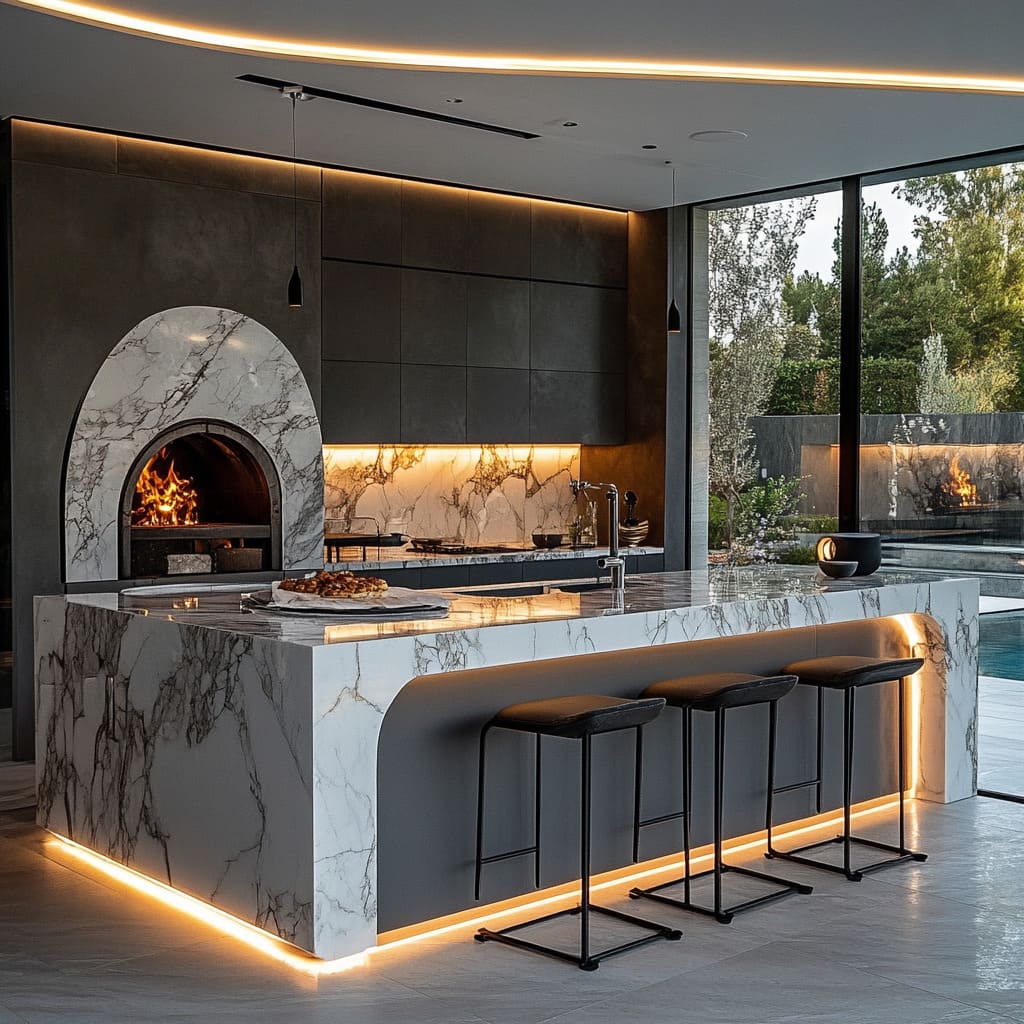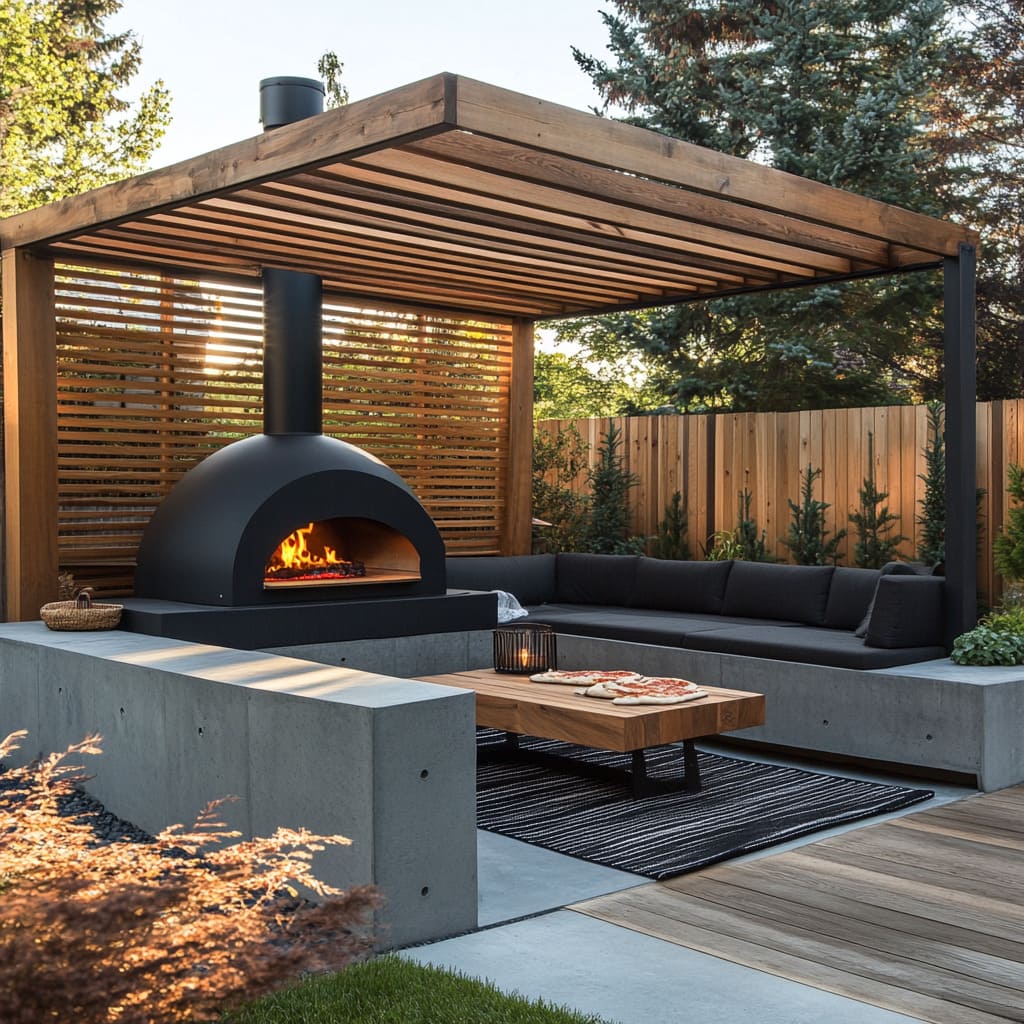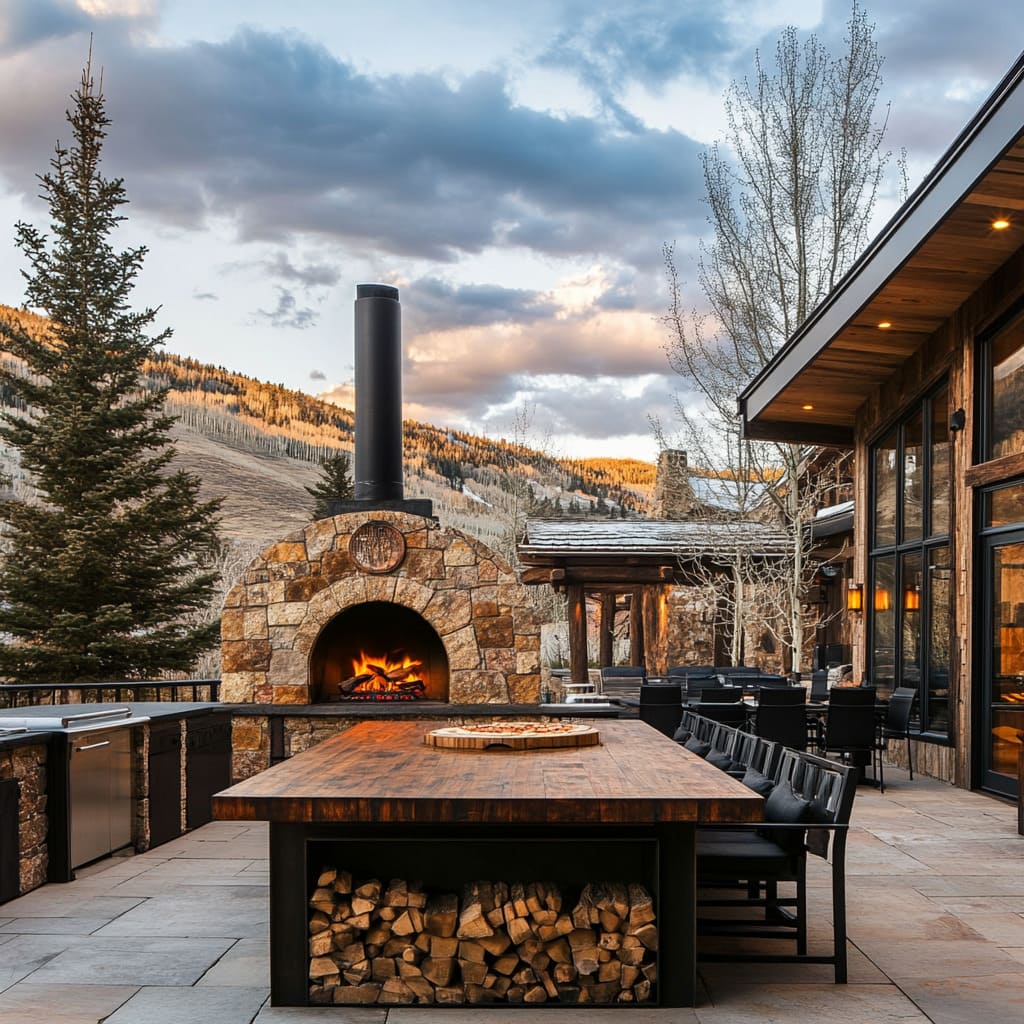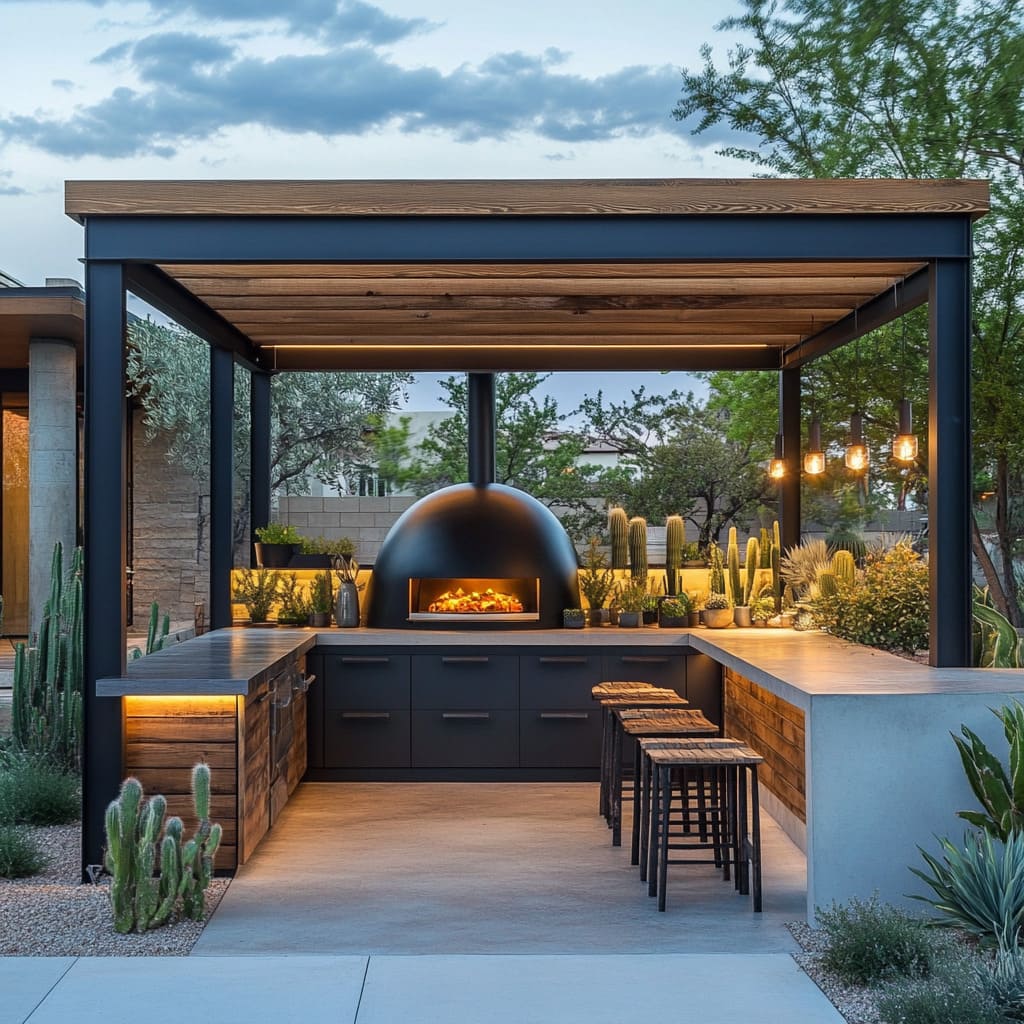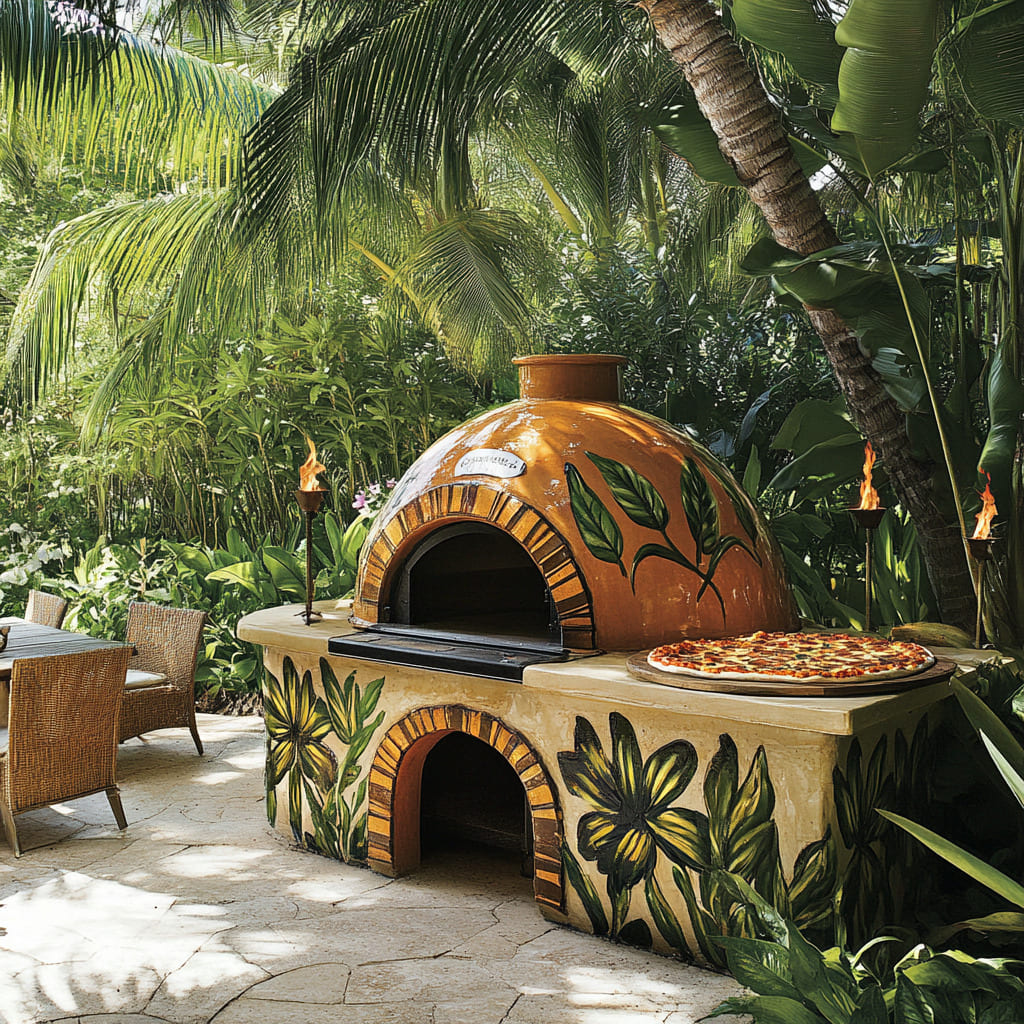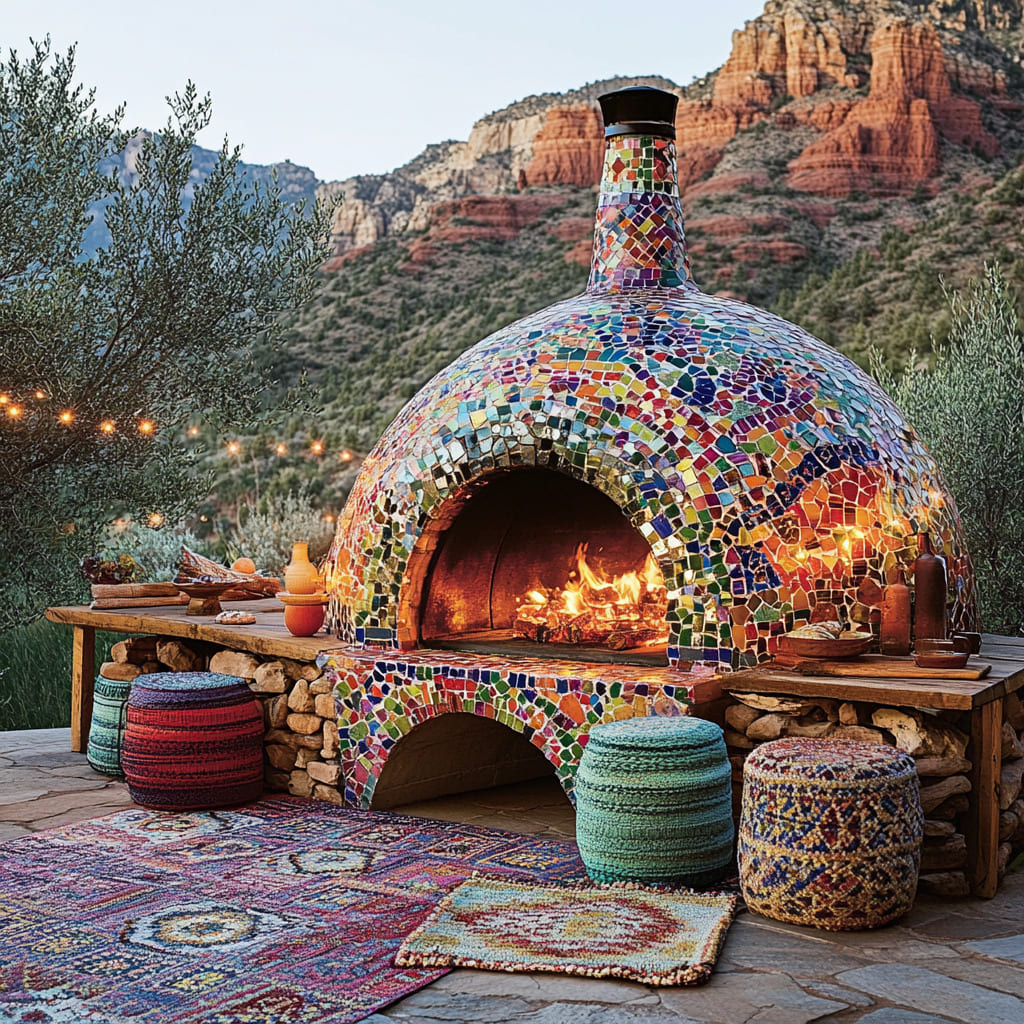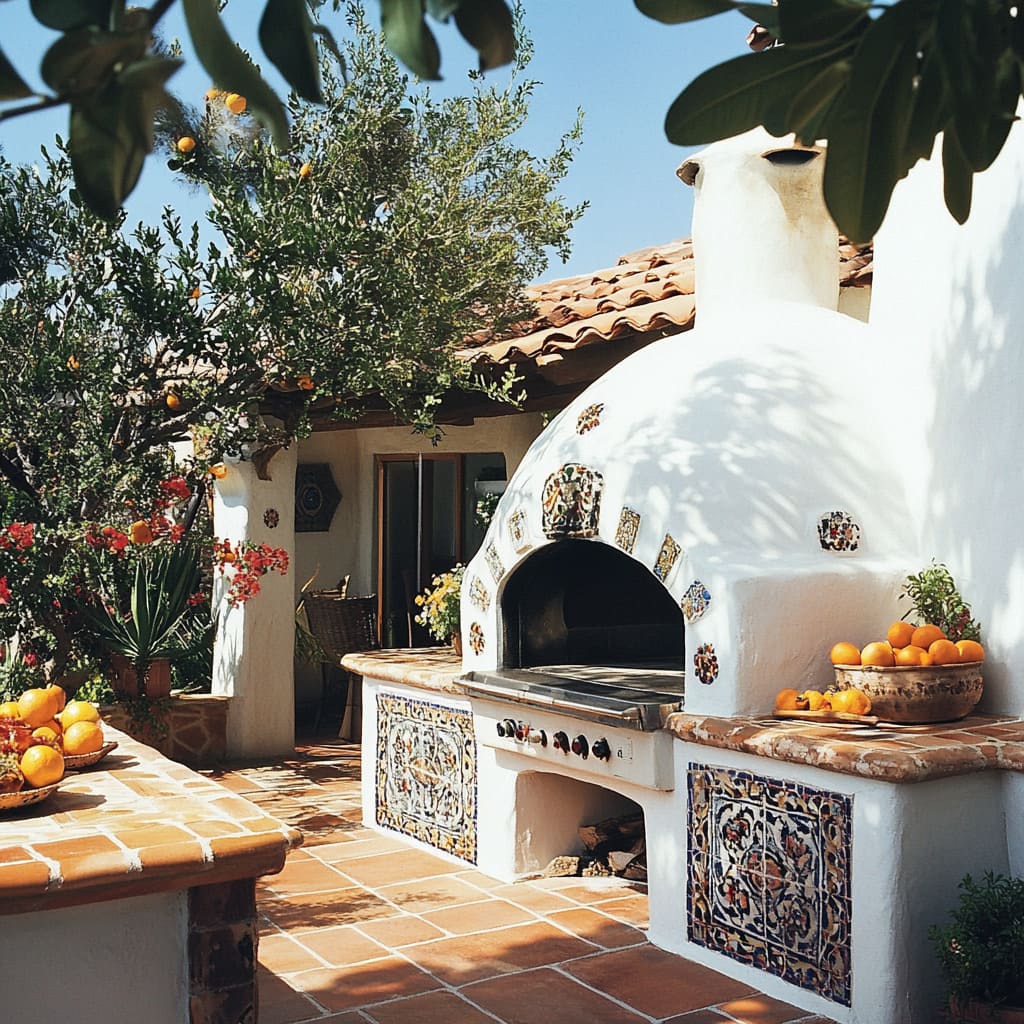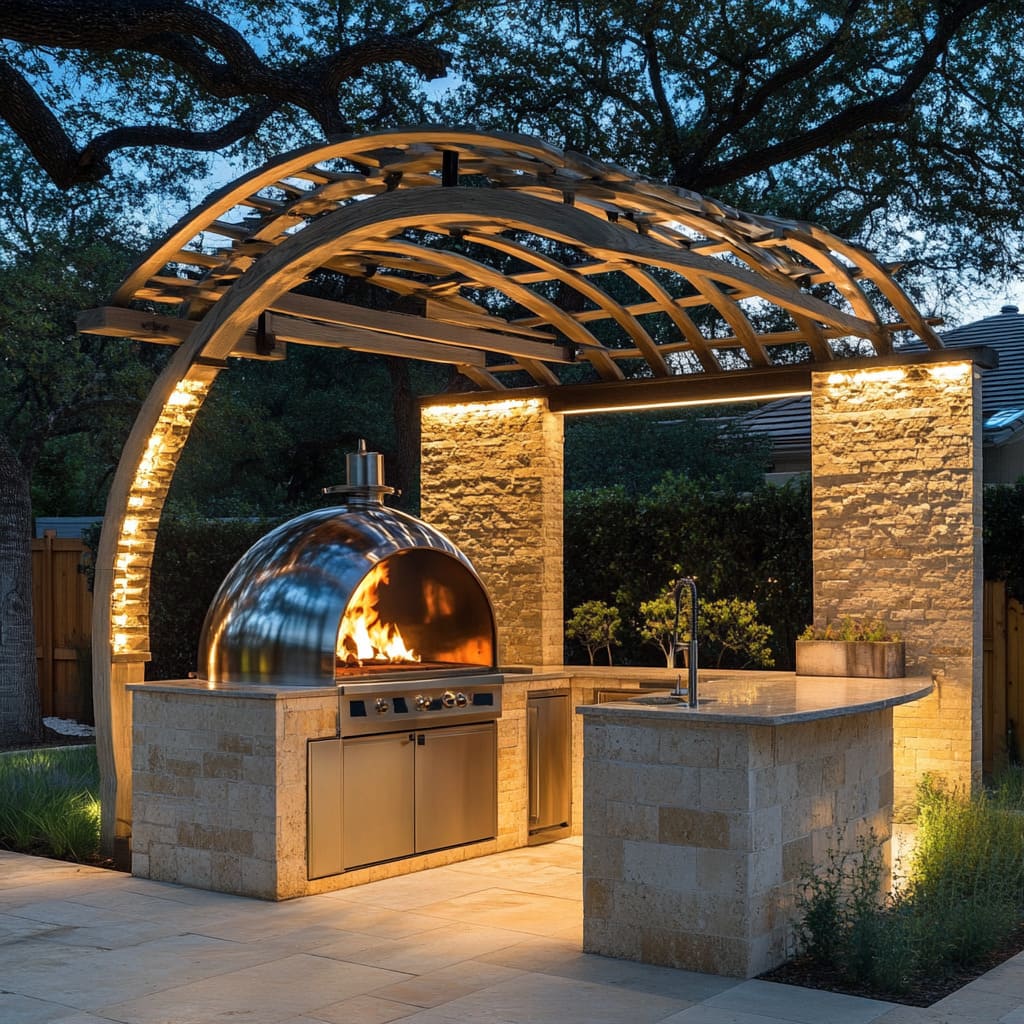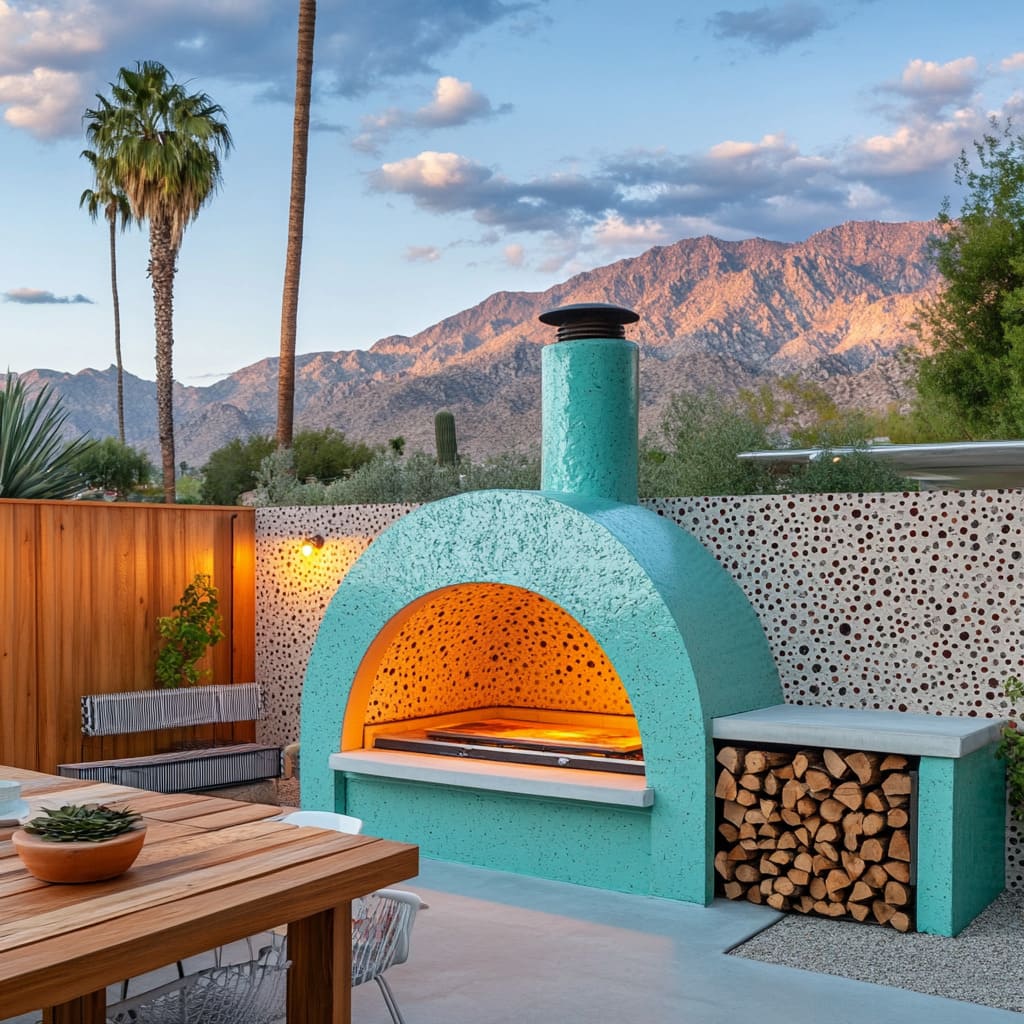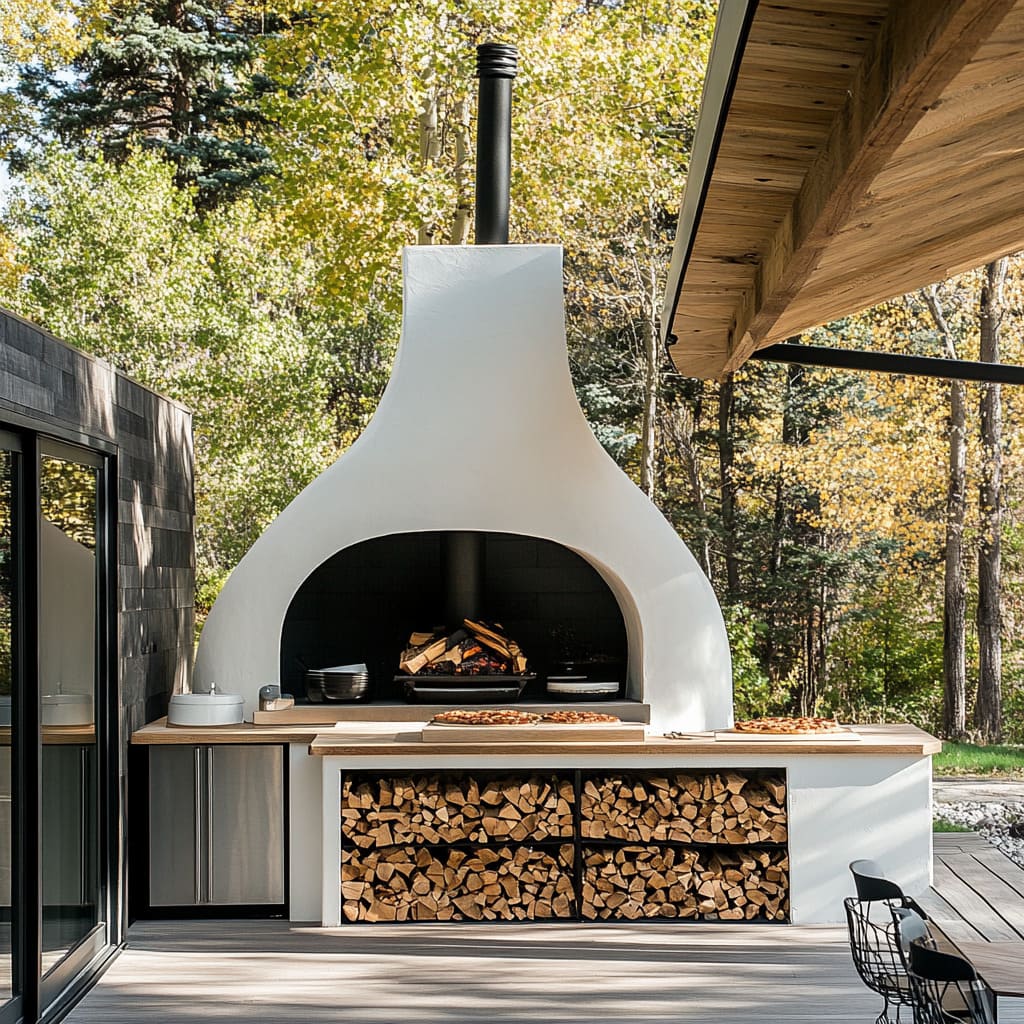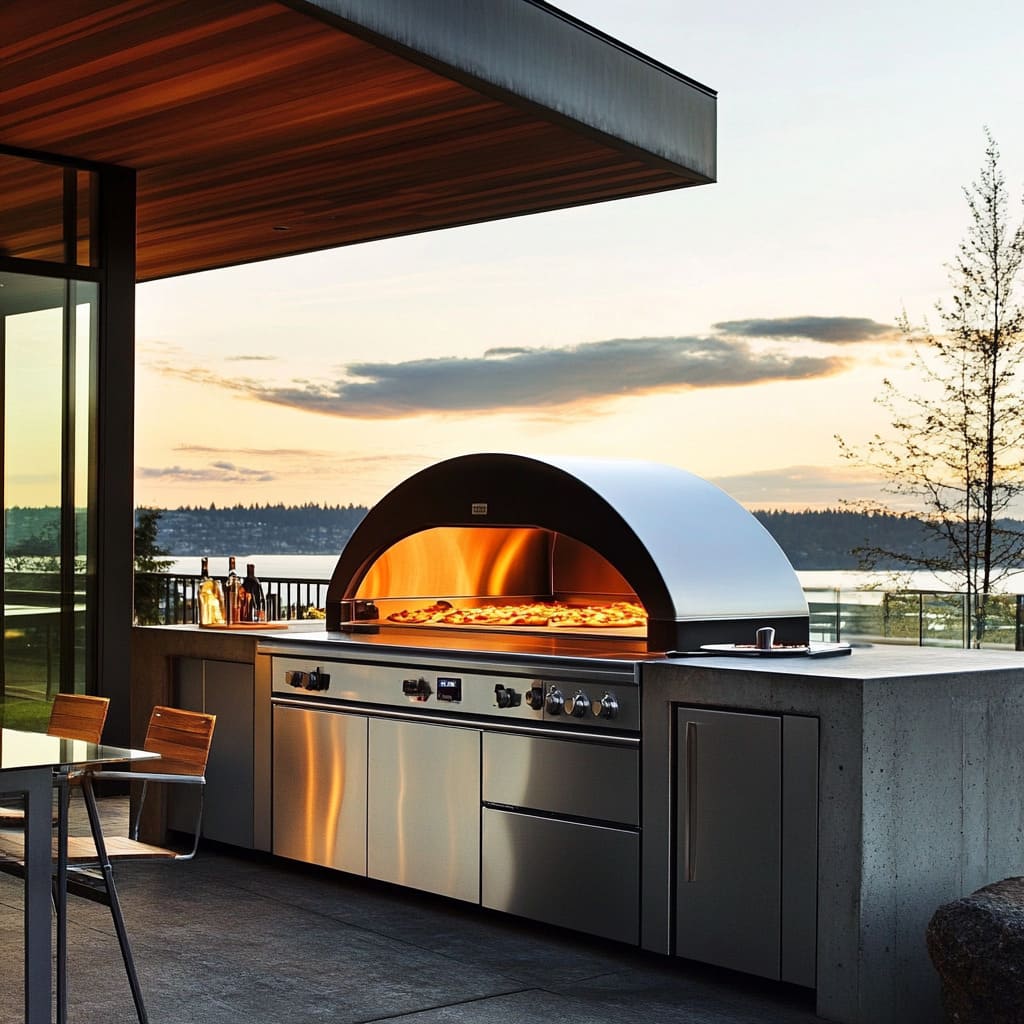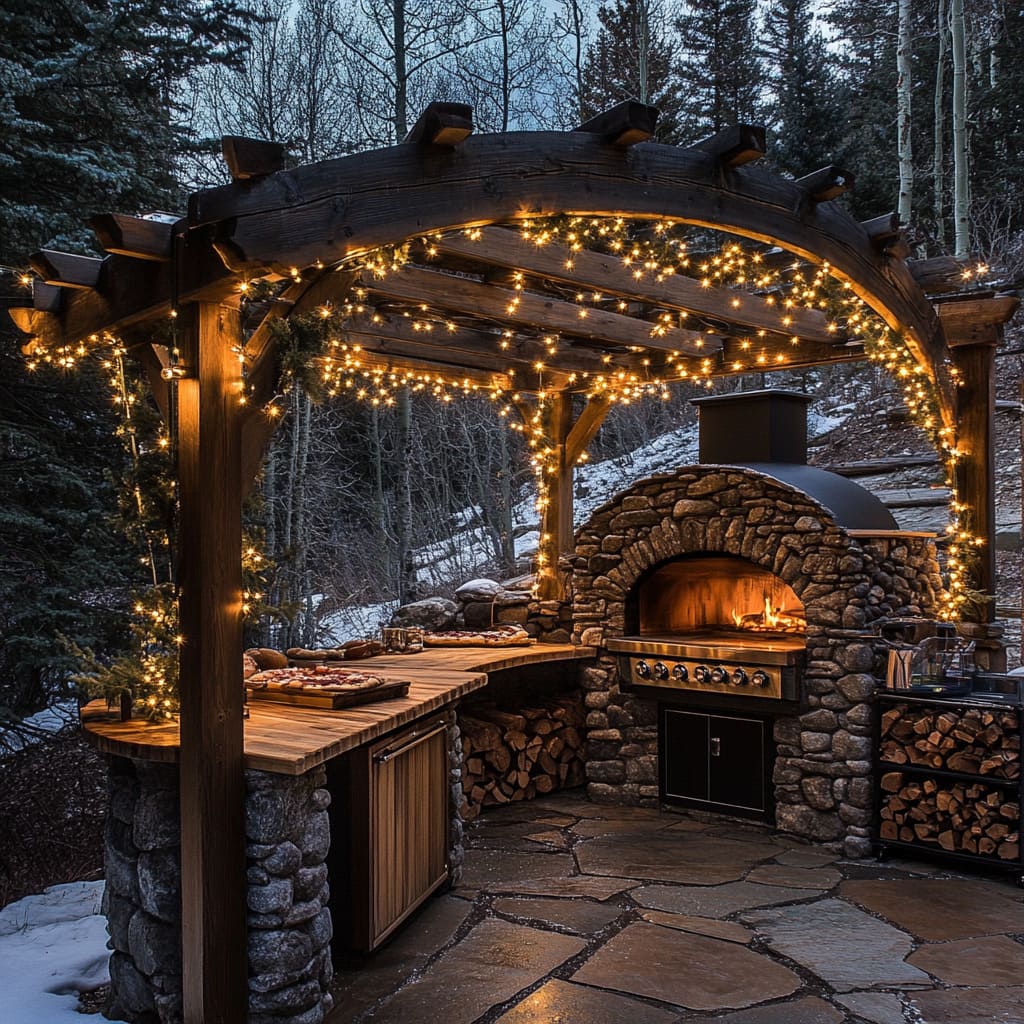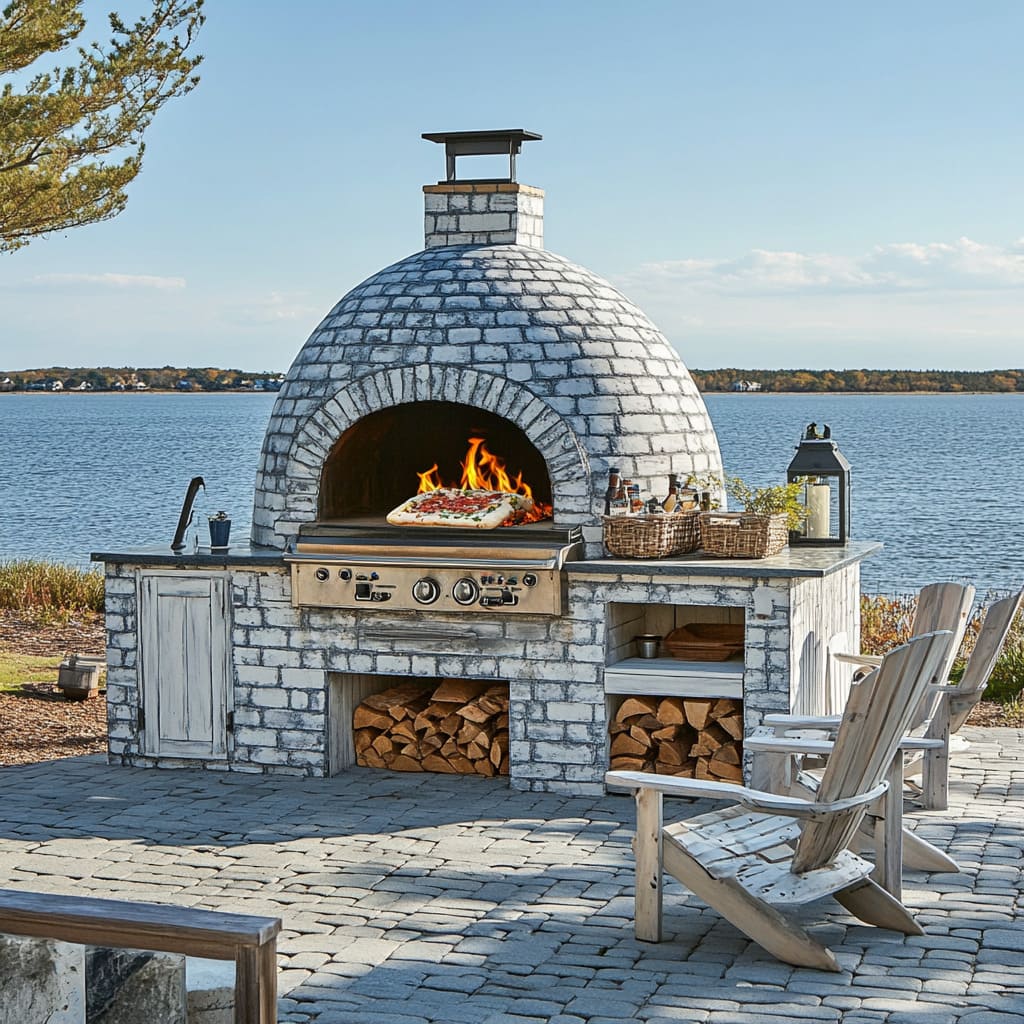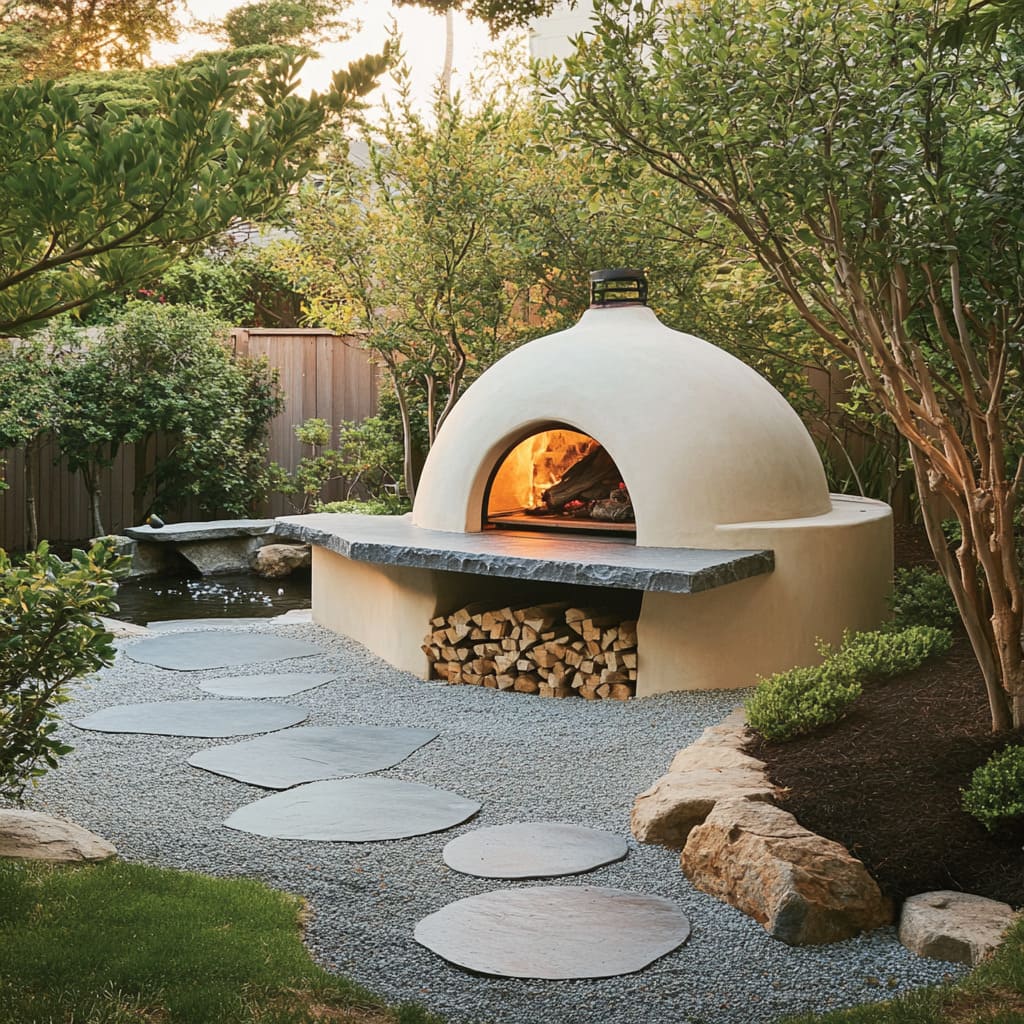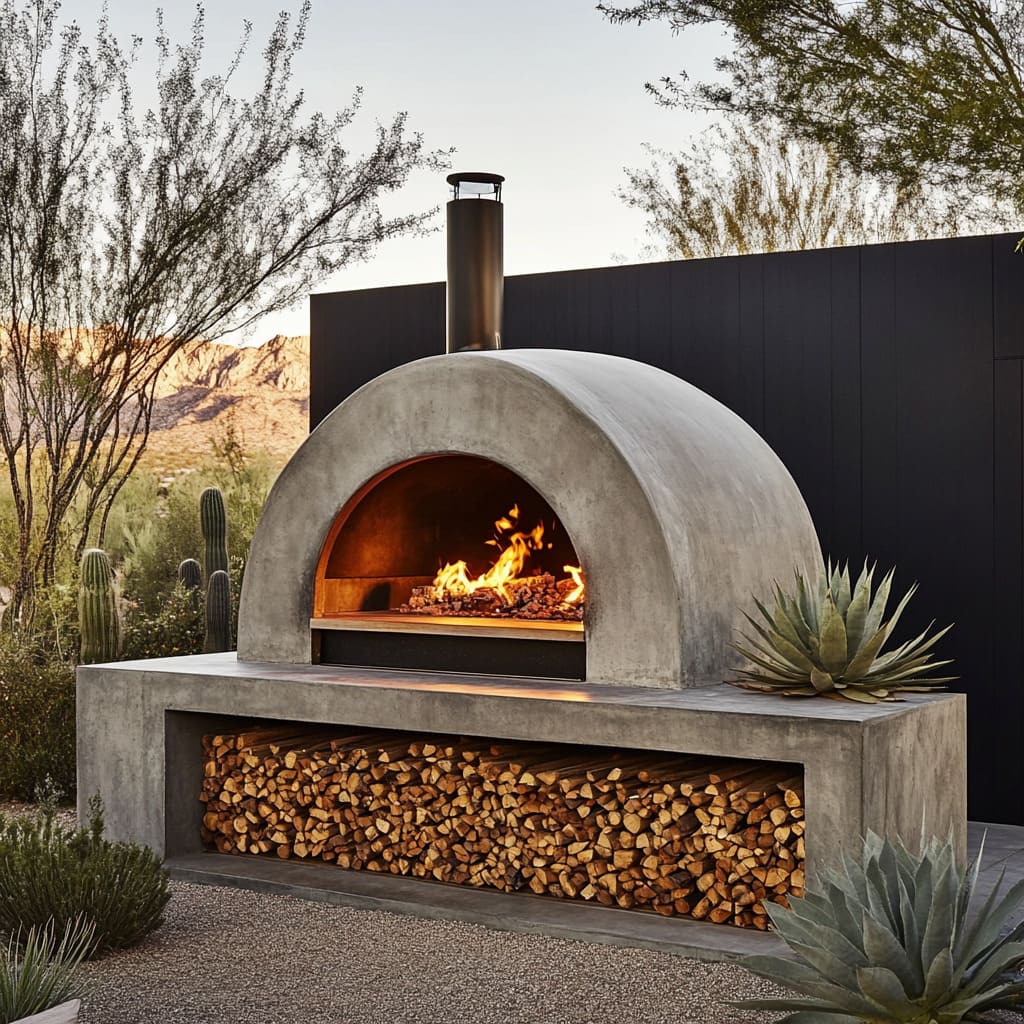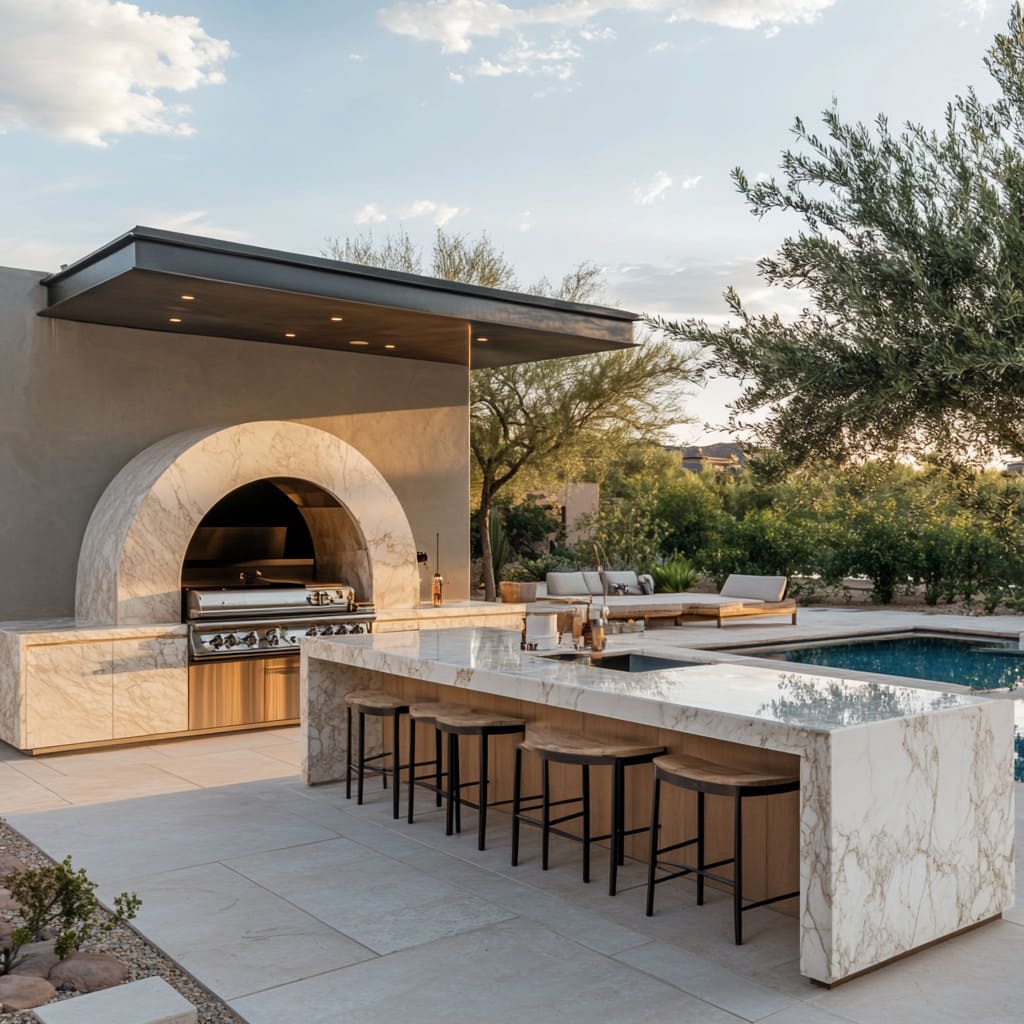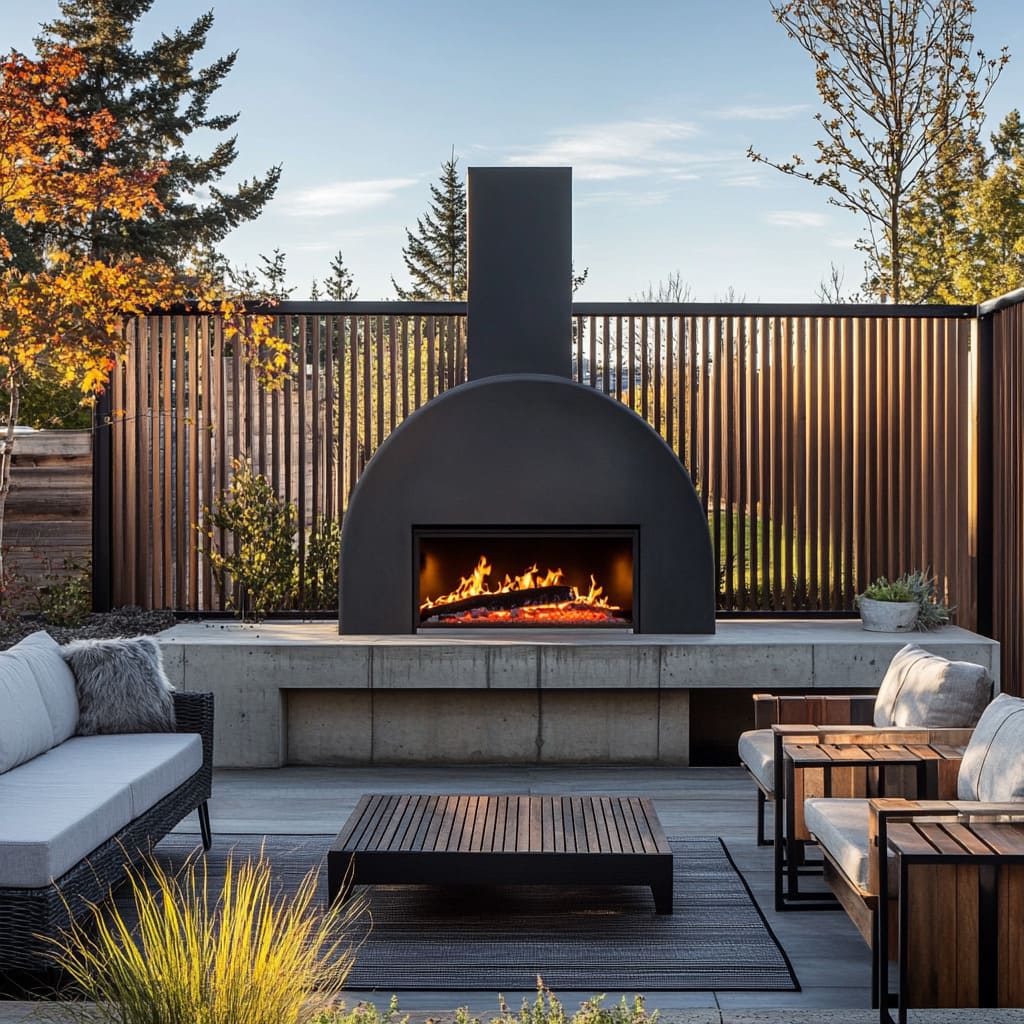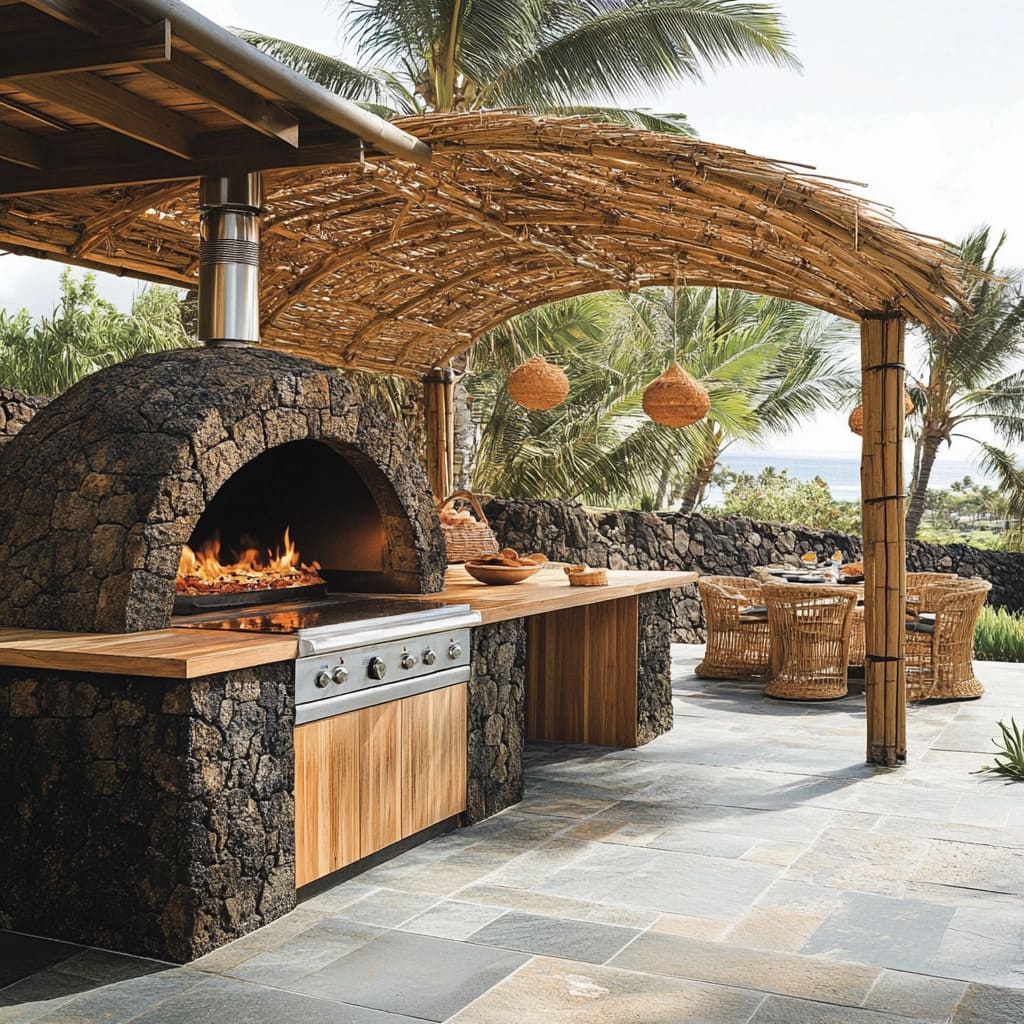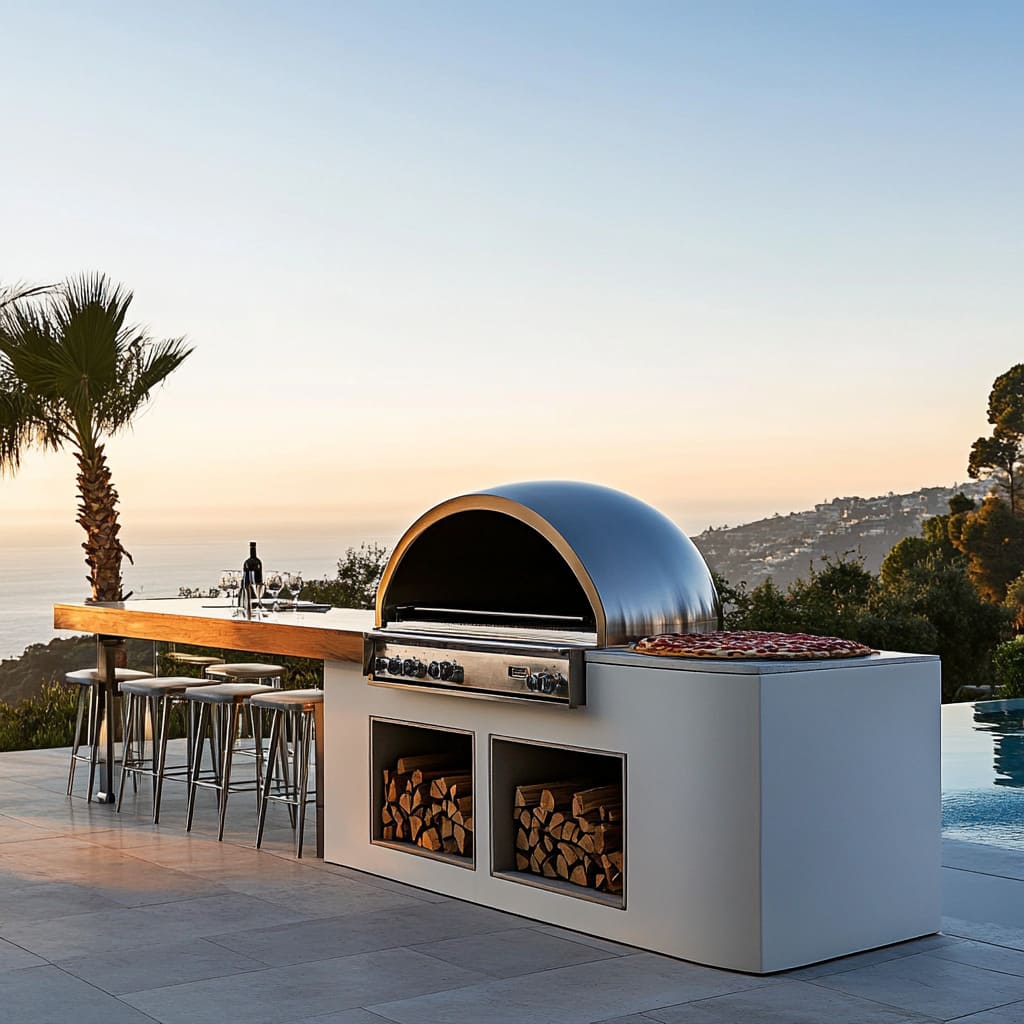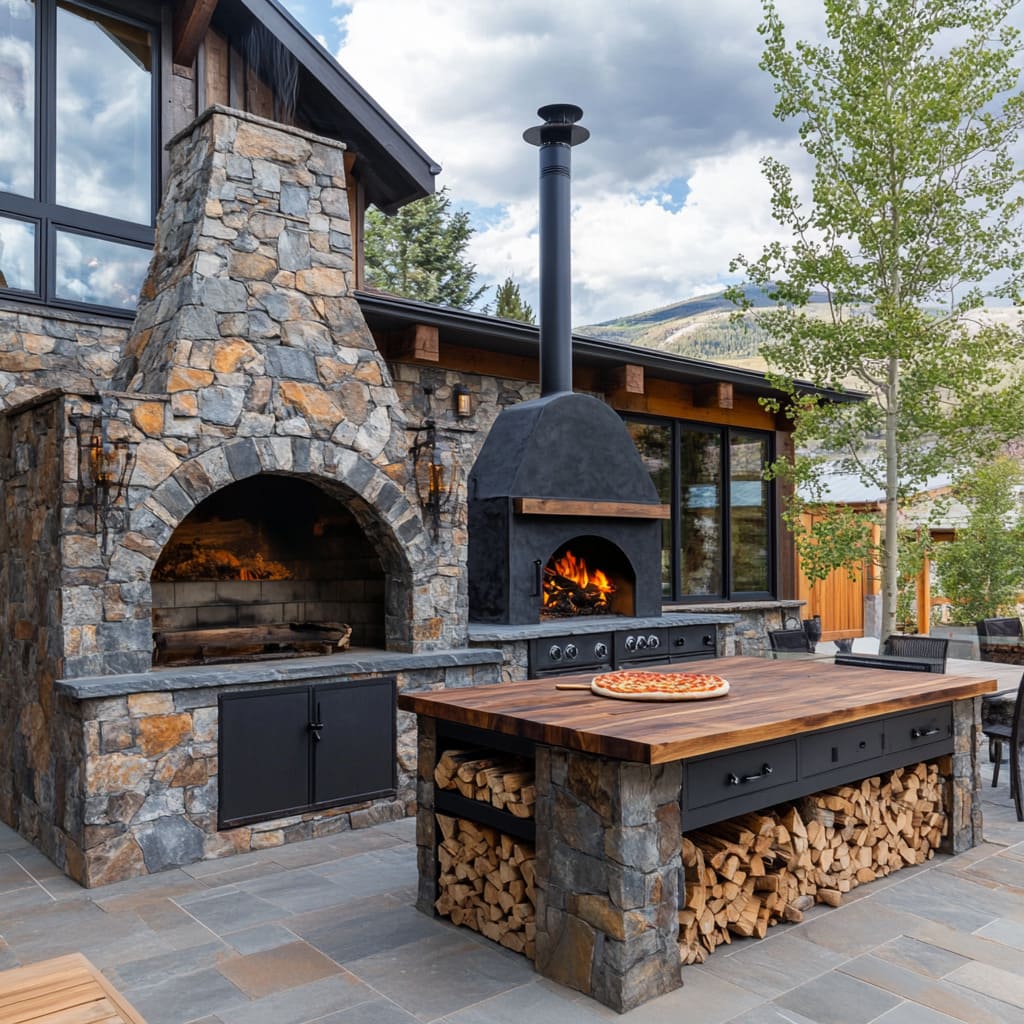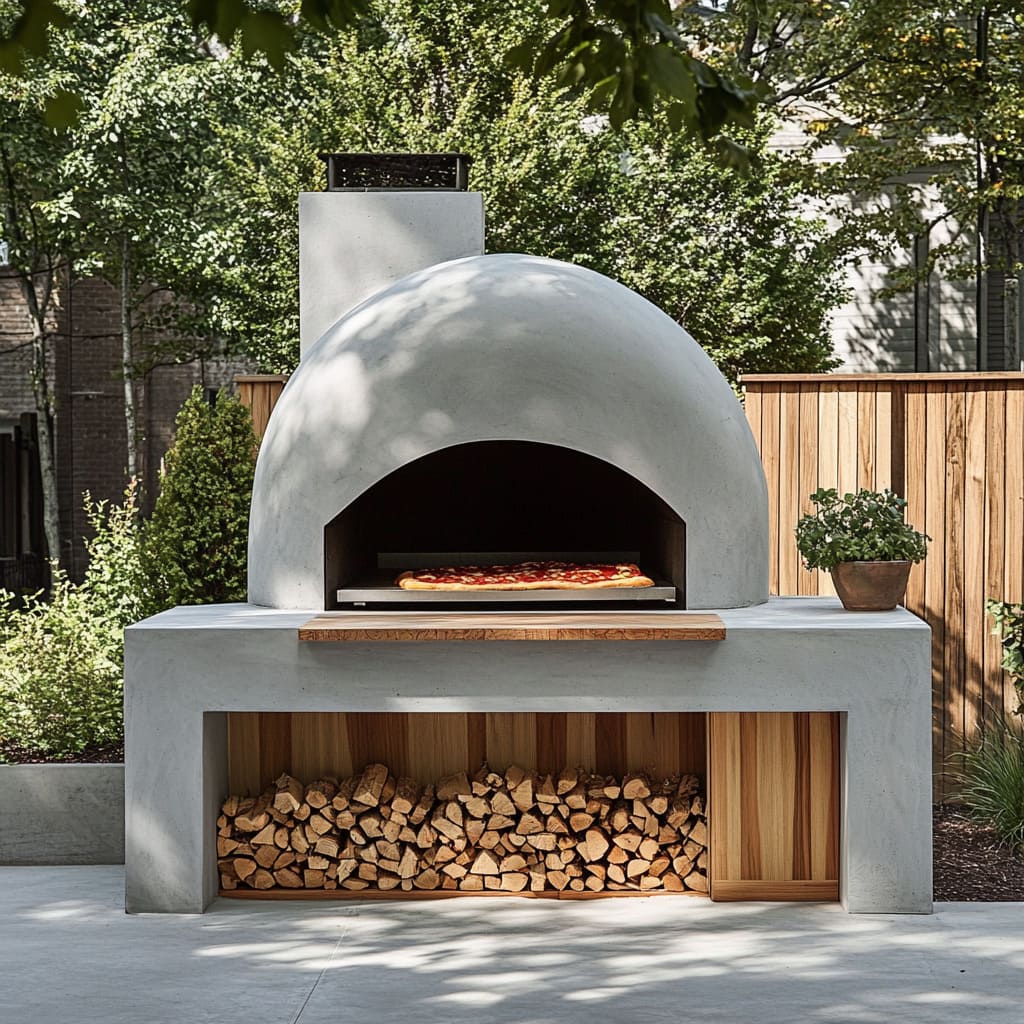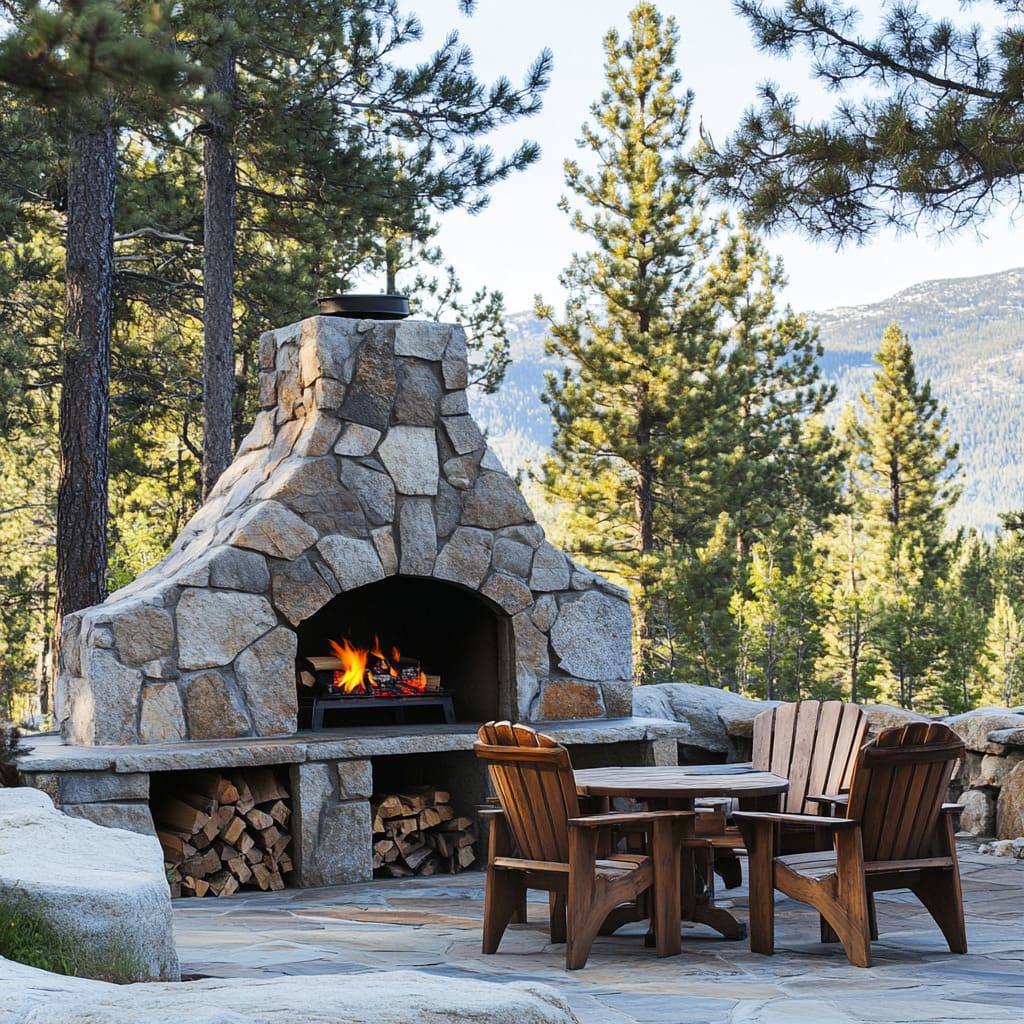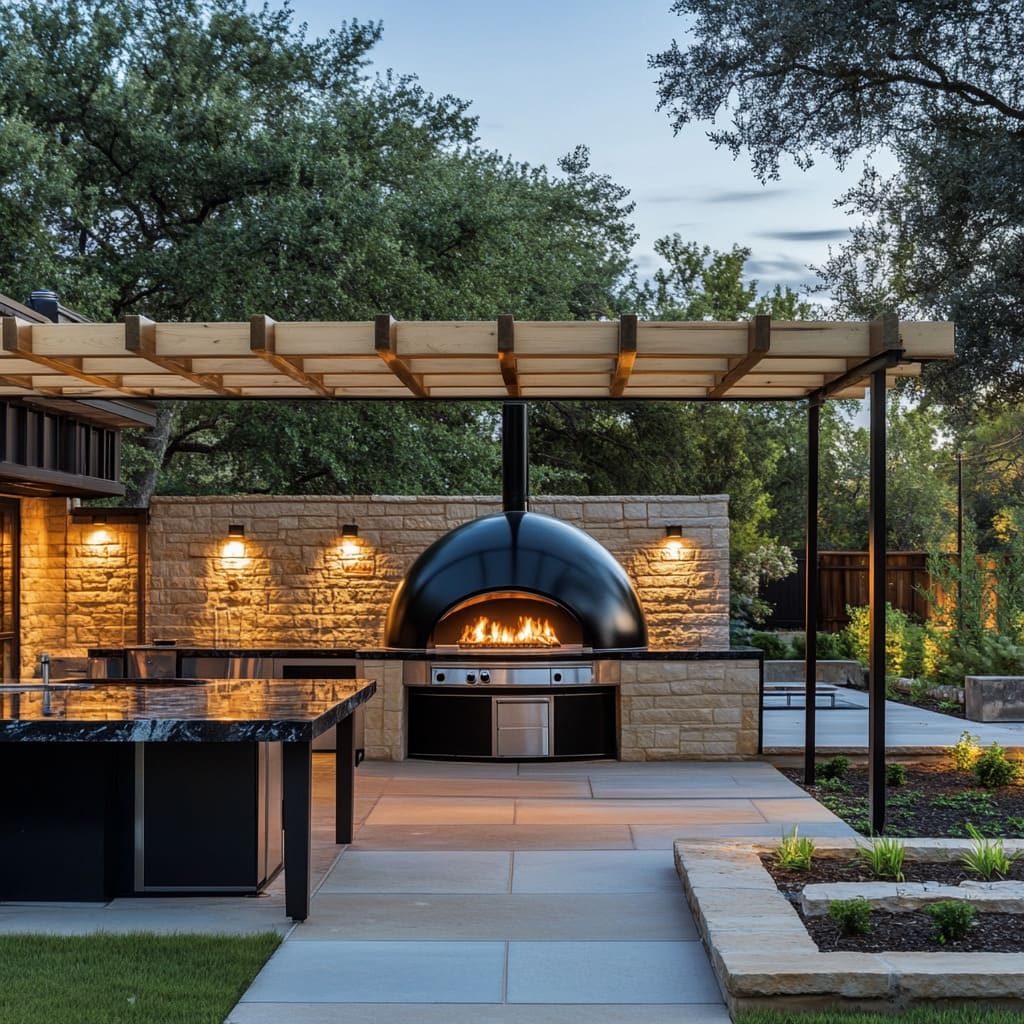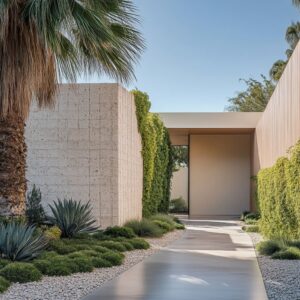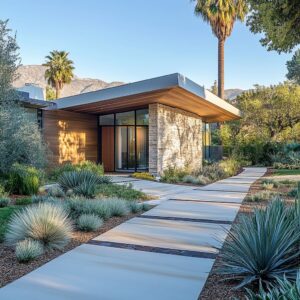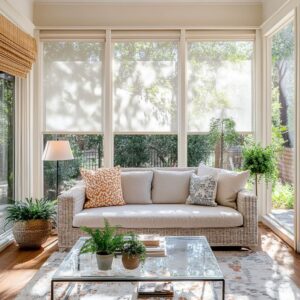The charm of a backyard pizza oven lies in its ability to transform outdoor spaces into lively and functional areas for cooking and gathering. An outdoor pizza oven design isn’t just about practicality; it’s a fusion of craftsmanship, style, and the art of creating a warm, inviting atmosphere.
Whether your vision includes a rustic stone oven tucked among lush greenery or a modern, steel-clad structure standing bold against a minimalist patio, the possibilities are as varied as your imagination.
This guide delves into the details that make these ovens not only functional but also visually striking. From selecting the right materials to aligning with your outdoor setting, each step in designing a pizza oven can turn your backyard into a personal culinary haven.
By exploring various styles, textures, and layouts, you’ll uncover how a carefully crafted design can enhance your outdoor living space and make it a place for unforgettable gatherings.
Color and Texture Choices
Bold or Bright Domes
Outdoor pizza oven designs often showcase their individuality through bold, attention-grabbing domes, and vibrant color palettes can completely transform the ambiance of a space. Imagine a turquoise dome perched in a sunny backyard—its brightness contrasts beautifully with earthy tones in mid-century-inspired layouts, as seen in Californian settings.
These ovens make a visual statement, such as the mosaic tile oven in Sedona, whose rich blend of blues, reds, and yellows creates a lively yet cohesive design. Vibrant colors act as focal points, drawing attention and adding contrast to neutral-toned environments like desert backyards or minimalist gardens.
Subtle/Neutral Domes
For those who prefer understated charm, neutral tones like white, black, or soft gray create a sophisticated look. Scandinavian-inspired white domes emphasize simplicity and purpose, while black domes radiate sophistication, blending seamlessly into urban settings.
Neutral domes complement larger outdoor setups by highlighting their surroundings, such as lush greenery or wood-paneled counters, rather than competing with them.
Stone, Stucco, or Marble Cladding
The surface finish of a pizza oven impacts both aesthetic appeal and tactile experience. Rough-hewn stone integrates beautifully into rustic backyards, while stucco domes deliver a customizable smooth finish ideal for Mediterranean or Southwestern designs.
For modern spaces, polished marble offers a luxurious touch, with its veined textures adding refinement and sleekness.
Integration with Surroundings
Natural Backdrops
For outdoor pizza ovens situated in forested or mountainous areas, the key to a harmonious design lies in echoing the natural surroundings. Stone bases with irregular textures and wood accents bring a sense of authenticity and grounding to the space.
These materials blend seamlessly into the environment, making the oven appear as if it has always been part of the landscape. This approach not only enhances the aesthetics but also elevates the overall dining experience, allowing you to enjoy both the warmth of the fire and the tranquility of nature.
Whether surrounded by towering evergreens or rugged cliffs, these ovens feel like an extension of the outdoors.
Urban or Modern Spaces
Urban designs often gravitate toward clean lines and minimalist materials that complement contemporary architecture. Concrete and stainless steel are popular choices, offering durability while maintaining a sleek and understated look.
Floating pizza oven setups, with their geometric forms and innovative placements, represent the best outdoor pizza oven design for modern spaces. These bold, structured styles not only serve as functional cooking tools but also double as striking visual statements.
Paired with modern patio furniture and subdued landscaping, these ovens transform any urban backyard into a refined and functional outdoor area.
Coastal or Tropical Settings
In coastal and tropical locations, outdoor pizza ovens reflect the relaxed and breezy atmosphere of their settings. Materials such as volcanic rock or tiles inspired by ocean waves capture the essence of these locales, offering durability against the elements while showcasing natural beauty.
Surrounding features like bamboo pergolas or woven lighting further emphasize the laid-back vibe, creating spaces that invite long evenings spent cooking and socializing. These designs often incorporate light, earthy tones and open layouts to complement the lush greenery or nearby water views, turning the outdoor oven into a centerpiece of effortless coastal living.
Multifunctional Layouts
Built-In Counters and Shelves
An efficient backyard pizza oven design goes beyond the oven itself, incorporating practical elements that elevate the cooking experience. Integrated countertops are a must-have feature, offering ample space for everything from rolling dough to arranging toppings and slicing fresh-out-of-the-oven pizzas.
Durable materials like stone or treated wood ensure the counters withstand outdoor elements while blending seamlessly with the oven’s design. Built-in cabinets beneath these counters provide a hidden storage solution, keeping tools, utensils, and ingredients organized.
This not only eliminates clutter but also maintains a polished, cohesive appearance, making the space as practical as it is stylish.
Firewood Storage
Incorporating thoughtful firewood storage into the design adds both function and charm. Recessed cubbies beneath the oven or along the base keep logs neatly arranged and within easy reach, streamlining the cooking process.
These storage spaces can also double as decorative elements, especially in urban setups where aesthetics play a critical role. Neatly stacked firewood introduces texture and a natural warmth, complementing the overall look of the oven area.
For those with a modern aesthetic, sleek metal or concrete frames around the cubbies provide a contemporary twist on this traditional feature.
Extended Bar or Dining Area
Turning the pizza oven zone into a vibrant social hub adds a whole new layer of enjoyment to outdoor cooking. Extended countertops or bar areas adjacent to the oven allow guests to gather comfortably, creating an inviting space for interaction and shared experiences.
High-quality materials like polished stone or treated wood elevate the overall design, while optional features like LED strip lighting under the bar add a touch of ambiance for evening events. These thoughtful additions make the area versatile—not only a cooking station but also a welcoming gathering spot for family and friends.
By blending functionality with hospitality, the space transforms into the centerpiece of your outdoor living area.
Architectural Features Above and Around the Oven
Pergolas and Canopies
A well-designed pergola or canopy serves as more than a decorative touch—it provides functionality and enhances the overall experience of your outdoor oven area. Wooden slats are a classic choice, offering filtered sunlight that creates a pleasant balance of shade and warmth.
This approach works beautifully in traditional or rustic settings where natural materials are part of the overall theme. For those seeking a modern edge, metal frames or minimalist structures can provide clean lines and a contemporary feel.
Beyond aesthetics, these features help define the cooking zone and make the space usable throughout the year, offering protection from both the sun and light rain. Whether rustic or modern, pergolas elevate any pizza oven design by giving it a sense of structure and purpose.
Light Fixtures
Lighting plays an essential role in setting the mood and ensuring functionality in the evening. String lights hung around the pergola or overhead create a cozy, festive ambiance, perfect for casual gatherings.
For a more refined look, recessed LEDs embedded in the pergola or counters highlight textures and materials, such as the polished stone or wood that often frames the oven area. Accent lighting near the oven opening can emphasize the warm glow of the fire, drawing attention to the heart of the space.
Thoughtful lighting choices transform the oven zone from a daytime cooking spot to an inviting nighttime retreat.
Privacy Screens and Walls
In urban or densely populated areas, privacy screens and walls provide both seclusion and visual interest. Vertical wood slats offer a natural, rustic charm while maintaining airflow and an open feel.
For a more contemporary aesthetic, perforated stone or concrete blocks introduce texture and light interplay, casting intricate patterns as the sun moves throughout the day. Greenery walls are another versatile option, combining functionality with aesthetics by adding a natural touch to the design.
These features create a more intimate and comfortable atmosphere, ensuring the space feels welcoming without sacrificing privacy. By blending practical elements with thoughtful design, privacy screens complement the overall architectural vision.
Subtle Functional Considerations
Ventilation and Chimney Placement
Effective ventilation is essential for any outdoor oven, both for safety and a comfortable cooking experience. A well-placed chimney ensures that smoke is efficiently directed away from guests and dining areas.
Chimney height and diameter play critical roles in achieving this, especially in setups where airflow needs careful management, such as in compact or enclosed backyard spaces. Modern chimney caps or vents not only improve functionality by optimizing airflow but also add a stylish finishing touch, enhancing the overall design.
Whether your oven is traditional stone or sleek stainless steel, the chimney can seamlessly blend into or contrast with the design, creating both practicality and aesthetic harmony.
Insulation and Heat Retention
The dome shape of a pizza oven is more than an iconic design—it’s a key factor in its performance. This shape allows heat to circulate evenly, ensuring consistent cooking temperatures for that perfect pizza crust.
Advanced insulation features, such as thermal layers or specialized linings, take this efficiency a step further, allowing the oven to maintain heat longer while reducing fuel consumption. These modern upgrades provide a fusion of traditional cooking methods and contemporary convenience, making your outdoor setup both authentic and easy to use.
Spatial Flow
The placement of your oven within the outdoor kitchen setup directly impacts its usability. Strategic positioning enhances movement between prep counters, the cooking area, and seating or dining spaces, creating a seamless and enjoyable experience.
For example, situating the oven near the prep zone minimizes steps during cooking, while placing it slightly apart from the dining area can keep the heat and activity at a comfortable distance for guests. Thoughtful spatial flow transforms the area into an efficient and inviting cooking space, ensuring your outdoor setup functions as beautifully as it looks.
Design Cohesion with Outdoor Furniture
Materials Echoing the Oven
Creating a cohesive outdoor space starts with harmonizing the materials of your oven and furniture. When your furniture reflects the textures or finishes of your oven, the result is a balanced and unified design.
For instance, a rustic stone pizza oven blends seamlessly with a matching stone table or benches crafted from wood with similar earthy tones. This alignment extends to other elements, such as the choice of materials for countertops, pergolas, or even outdoor shelving.
Incorporating consistent textures ensures the oven isn’t just a functional feature but an integral part of the overall aesthetic. For a more contemporary vibe, a stainless steel oven might pair perfectly with sleek metal chairs or tables that echo its polished finish.
Alternatively, a stucco oven could be complemented by outdoor seating with soft fabric cushions and smooth frames, mirroring the simplicity and adaptability of the stucco’s surface. The key is to create visual flow by ensuring the furniture and oven feel intentionally connected.
Color Accents
Vibrant setups thrive on thoughtful coordination of color. If your oven features bold hues—like a mosaic tile design or a bright stucco finish—accentuating these tones through surrounding elements can tie the entire space together.
Planters, outdoor rugs, or cushions in complementary shades can help reinforce the design theme. For example, a turquoise oven might be paired with planters featuring shades of green or yellow, echoing its lively energy.
For neutral-toned ovens, subtle color accents can prevent the space from feeling too subdued. Use decorative pillows, throws, or even potted plants to introduce layers of color that enliven the area without overpowering the overall look.
This approach ensures the oven doesn’t stand out as an isolated element but feels like a natural and integrated part of the backyard setting. Whether through coordinated materials or subtle color choices, these thoughtful details help create an inviting outdoor space with seamless design cohesion.
Cultural or Thematic Influences
Mediterranean and Southwestern Styles
Mediterranean-inspired outdoor pizza ovens bring a sense of warmth and tradition to backyard spaces, with their signature use of terracotta tiles and intricate mosaics. These designs often incorporate earthy, sunbaked tones that reflect the landscapes of coastal regions, creating a timeless and inviting aesthetic.
A Mediterranean oven might feature tiled accents in vibrant blues and whites, reminiscent of seaside villas, paired with arched fireboxes that add character and charm. Southwestern designs, on the other hand, celebrate the rugged beauty of desert landscapes with their earthy palettes and natural textures.
Stucco finishes in sandy tones, combined with decorative tile borders or stone bases, evoke the casual elegance of Southwestern architecture. These styles often integrate seamlessly with cacti, succulents, or other drought-tolerant landscaping, enhancing the oven’s connection to its environment.
Mid-Century Modern
Mid-century modern designs take a different approach, focusing on clean lines and geometric patterns that offer a retro yet contemporary vibe. These ovens are characterized by bold shapes and materials that reflect the minimalist ethos of the mid-20th century.
For example, a dome oven with a smooth, vibrant-colored finish might be paired with breeze block walls or perforated screens, tying the oven into the larger design narrative of the backyard. The simplicity of mid-century modern ovens makes them adaptable to a range of spaces, whether as a striking focal point or a subtle addition to a retro-themed patio.
Their streamlined shapes and attention to detail add sophistication while maintaining a functional, uncluttered look.
Scandinavian Minimalism
Scandinavian-style outdoor ovens embrace simplicity, functionality, and natural materials, making them ideal for those who value a minimalist aesthetic. Light wood paneling, crisp white stucco finishes, and smooth, rounded forms are common features, creating an understated elegance that feels both modern and timeless.
These designs often prioritize harmony with the surrounding environment, incorporating features like neatly stacked firewood or soft, neutral color palettes that blend with greenery. A Scandinavian oven might be paired with furniture in natural finishes and clean lines, ensuring a cohesive and calming outdoor atmosphere.
By focusing on functionality without sacrificing style, these ovens capture the essence of Scandinavian design—creating spaces that feel purposeful and welcoming.
Practical Guidance for a Similar Backyard Setup
Creating a backyard oven that seamlessly blends functionality and aesthetics requires careful planning and attention to detail. This guide explores the essential aspects of designing an oven setup tailored to your space, climate, and personal style.
By understanding the materials, structure, and layout options, you can achieve an inviting and efficient cooking area that suits both everyday use and special gatherings.
Assess Climate and Materials
- Rainy or Snowy Climates: In regions with frequent rain or snow, prioritize materials like high-quality stucco, sealed stone, or stainless steel. For example, stucco can be sealed to withstand harsh weather while maintaining a smooth appearance.
- Dry, Hot Climates: Porous stones or masonry, such as volcanic rock or untreated stone, are excellent for arid areas, blending naturally with desert landscaping.
- Locally Sourced Materials: Incorporating region-specific materials like native stone or handmade tiles reduces costs and enhances visual cohesion while aligning with sustainable practices.
Plan the Oven’s Core Structure
- Dome Shape: The dome shape is a key component of optimal heat retention. Options like traditional curved domes or spherical designs offer both functionality and artistic appeal.
- Base Design: A stable foundation, such as a reinforced concrete slab, ensures structural integrity. Adding under-oven storage or integrated cabinets enhances functionality and tidiness.
Mind Your Ventilation and Smoke Control
- Chimney Height and Diameter: The right size and placement of the chimney ensure effective airflow and smoke management, contributing to both functionality and aesthetic balance.
- Top-Vent vs Side-Vent Chimneys: Top-vent designs complement traditional styles, while side-vent options offer a modern look suitable for minimalist spaces.
Select Finishes to Match Your Aesthetic Goals
- Natural Stone: Perfect for an earthy, timeless atmosphere, natural stone works well in rustic setups and enhances durability.
- Stucco: This versatile finish offers a clean, customizable surface, ideal for Mediterranean or Southwestern settings.
- Marble or Polished Stone: For a sleek, high-end appearance, marble provides refinement and suits luxury-focused designs.
Create Functional Countertop and Seating Arrangements
- Countertop Space: Stone or concrete countertops offer ample workspace and durability for outdoor conditions.
- Hosting Features: Adding a dining ledge or bar near the oven enhances social interaction and creates a welcoming atmosphere.
- Log Storage and Efficiency: Neatly arranged firewood storage improves organization while adding a rustic visual element to the space.
Incorporate Layered Lighting
- Overhead and Accent Lighting: Warm-toned bulbs near the oven opening provide visibility and ambiance, especially for nighttime cooking.
- Under-Counter Strips: LED strip lighting adds a refined touch to modern setups, highlighting the material while enhancing functionality.
Merge Landscaping for Cohesion
- Rustic Designs: Potted herbs and climbing vines create a natural and inviting atmosphere, complementing stone oven designs.
- Modern Minimalism: Low-maintenance greenery like succulents adds structure without overwhelming the space.
- Paths and Features: Stone pathways or water features near the oven transform the area into a complete outdoor retreat.
Test Ergonomics and Safety
- Comfortable Working Height: Position the oven opening at a comfortable height to prevent strain during use.
- Clearance and Fire Safety: Ensure adequate clearance and use non-combustible materials for safety. Consulting specialists can ensure compliance with standards.
Consider Personal Touches
- Decorative Elements: Custom tiles or paintwork reflect your personality and add a unique charm.
- Personalized Plaques: A family name or symbol carved into a plaque adds a memorable finishing touch.
- Theme-Driven Accessories: Furniture and decor tailored to specific styles—such as woven furniture for rustic spaces or metal chairs for modern designs—enhance cohesion.
By paying attention to these details, you can create an outdoor oven setup that is both functional and visually harmonious, serving as a gathering point for cherished moments.
Conclusion
Creating a backyard pizza oven setup is more than assembling a cooking appliance—it’s about designing an outdoor space that merges functionality, style, and a touch of individuality. The process combines thoughtful architecture, strategic material choices, and practical aspects of heat efficiency to craft an area that serves as both a culinary hub and a social anchor.
The design must take cues from the local climate and existing landscaping to ensure a cohesive and durable setup. For instance, a stone oven nestled in a lush garden can feel like a natural extension of the environment, while a sleek stainless-steel dome can act as a contemporary centerpiece in an urban patio.
Each material and texture—whether rough-hewn stone, polished marble, or vibrant stucco—contributes to setting the mood and enhancing the visual appeal of the space.
Attention to details such as chimney placement, ergonomic working height, and the arrangement of counters or seating elevates a backyard pizza oven into more than a cooking station. It becomes a destination where form meets function.
Integrated features, like firewood storage, layered lighting, or a bar counter for guests, add practicality while fostering memorable gatherings. The beauty of outdoor oven designs lies in their versatility.
They can adapt to a variety of styles and personal preferences, reflecting the homeowner’s unique taste. Whether your goal is a rustic, nature-inspired look or a bold, modern statement, the best setups balance utility with character.
This harmony ensures the oven doesn’t just blend into the background but enhances the overall ambiance of your backyard.
Ultimately, designing a pizza oven space is an opportunity to bring creativity into your home’s outdoor living area. By prioritizing details like material compatibility, spatial layout, and aesthetic coherence, you can create an outdoor pizza kitchen that doesn’t just serve meals but also fosters connection, relaxation, and enjoyment.
It’s not only a cooking device—it’s the centerpiece of shared experiences and lasting memories.
